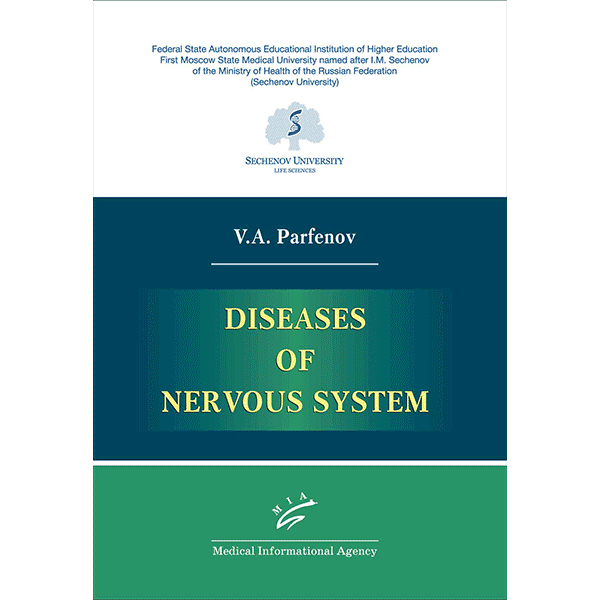Diseases of nervous system – Parfenov V. A.
Book "Diseases of nervous system"
Author: Parfenov V. A.
ISBN 978-5-9986-0514-7
Книга продается только по предоплате!
The main methods of neurological examination, symptoms, syndromes and topical diagnosis of lesions of the nervous system are described in the textbook. The etiology, pathogenesis, clinical picture, diagnosis, differential diagnosis, conservative and surgical treatment of the main diseases of the nervous system are outlined. The textbook is aimed at the formation of clinical thinking, the ability to diagnose major neurological diseases, prescribe effective treatment and conduct timely prevention. Clinical problems and tasks in a test form will allow students and young doctors to check the assimilation of educational material, prepare for tests and exams. For students of medical universities, clinical residents and neurologists.
Book's contents "Diseases of nervous system" - Parfenov V. A.
Chapter 1
Somatic sensation disorders
1.1. Morphophysiological basis of somatic sensation
1.1.1. Tactile and proprioceptive sensation
1.1.2. Pain and temperature sensation
1.2. Patient evaluation
1.3. Clinical manifestations of sensory disorders at different levels of damage
Chapter 2
Movement disorders
2.1. Central and peripheral paresis
2.1.1. Morphophysiological characteristics of the corticomuscular pathway
2.1.2. Рatient evaluation
2.1.3. Clinical manifestations of the upper and lower motor neuron lesions, topical diagnosis
2.2. Extrapyramidal motor system, extrapyramidal disorders
2.2.1. Morphophysiological basis of extrapyramidal system
2.2.2. Patient evaluation
2.2.3. Clinical manifestations of extrapyramidal movement disorders
2.3. Coordination of movements and its disorder
2.3.1. Morphophysiological basis for coordination of movements
2.3.2. Patient evaluation
2.3.3. Clinical manifestations of coordination disorders, types of ataxias, topical diagnosis
Chapter 3
Syndromes of damage to the spinal cord, its roots, peripheral nerves, and nerve plexuses
3.1. Morphophysiological basis of the functions of the spinal cord, spinal and peripheral nerves, plexuses
3.2. Clinical manifestations of damage to the spinal cord, its roots and spinal nerves, topical diagnosis
3.3. Peripheral nerve damage
Chapter 4
Change in sense of smell. Damage to the olfactory nerve
4.1. Morphophysiological basis of the function of smell
4.2. Patient evaluation
4.3. Clinical manifestations of olfactory disorder, topical diagnosis
Chapter 5
Visual impairment. Optic nerve damage
5.1. Morphophysiological basis of the function of vision
5.2. Patient evaluation
5.3. The main neurological causes of visual impairment, topical diagnosis
Chapter 6
Disorders of the oculomotor functions, damage to the oculomotor nerves
6.1. Morphophysiological basis of oculomotor functions
6.2. Methods for evaluating oculomotor functions and pupil reactions
6.3. Clinical manifestations and causes of oculomotor dysfunction, topical diagnosis
6.4. Causes of oculomotor and pupil disorders
Chapter 7
Sensation changes in the face and head.
Damage to trigeminal nerve
7.1. Morphophysiological basis of sensation in the face and head
7.2. Assessment of trigeminal function
7.3. Clinical manifestations of sensory impairment in the face and head and chewing muscles, topical diagnosis
Chapter 8
Damage to facial muscles and taste. Facial nerve damage
8.1. Morphophysiological basis of the functions of the facial nerve
8.2. Patient evaluation
8.3. Clinical manifestations and causes of facial nerve damage, topical diagnosis
Chapter 9
Vestibulo-cochlear nerve, vestibular disorders, impaired hearing
9.1. Morphophysiological basis of hearing and the vestibular system
9.2. Patient evaluation
9.3. Clinical manifestations
9.4. Causes of vertigo and sensorineural hearing loss
9.4.1. Benign paroxysmal positional vertigo
9.4.2. Meniere’s disease
9.4.3. Vestibular neuritis
9.4.4. Vestibular migraine
9.4.5. Central vertigo
Chapter 10
Swallowing and phonation disorders.
Glossopharyngeal and vagus nerves lesions
10.1. Morphophysiological basis of the functions of the glossopharyngeal and vagus nerves
10.2. Patient evaluation
10.3. Clinical manifestations of lesion of the glossopharyngeal and vagus nerves
10.4. The main causes of the glossopharyngeal and vagus nerves lesions
10.5. Bulbar and pseudobulbar palsy
Chapter 11
Paresis of the sternocleidomastoid and trapezius muscles.
Accessory nerve lesion
11.1. Morphophysiological basis and evaluation of the functions
of the accessory nerve
11.2. Clinical manifestations and causes of damage to the accessory nerve
Chapter 12
Paresis of the tongue. Hypoglossal nerve lesion
12.1. Morphophysiological basis and the study of the functions of the hypoglossal nerve
12.2. Clinical manifestations and causes of damage to the hypoglossal nerve
Chapter 13
Disorders of consciousness
13.1. Morphophysiological basis of consciousness
13.2. Forms of impaired consciousness, patient evaluation
13.3. Destructive and metabolic coma
13.4. Chronic vegetative state, minimally conscious state, brain death
Chapter 14
Disorders of higher mental functions.
Emotional and behavioral disorders
14.1. Morphophysiological basis of the higher brain functions
14.2. Clinical manifestations of disorders of the higher brain functions
14.2.1. Amnesia (memory impairment)
14.2.2. Agnosia
14.2.3. Apraxia
14.2.4. Aphasia
14.2.5. Executive functions impairment
14.2.6. Cognitive impairment, dementia, delirium
14.3. Emotional and behavioral disorders
14.4. Patient evaluation
Chapter 15
Meningeal and hypertensive syndromes, hydrocephalus
15.1. Morphophysiological characteristics of the meninges and ventricles
of the brain, cerebrospinal fluid circulation
15.2. Patient evaluation
15.3. Meningeal syndrome
15.4. Intracranial hypertension
15.5. Hydrocephalus
Chapter 16
Autonomic disorders
16.1. Morphophysiological characteristics of the autonomic nervous system
16.2. Patient evaluation and clinical manifestations of autonomic disorders
Chapter 17
Neurogenic bladder dysfunction, neurogenic bowel dysfunction
17.1. Neurogenic bladder dysfunction
17.2. Neurogenic bowel dysfunction
Chapter 18
Laboratory and instrumental examinations
18.1. Needle electromyography
18.2. Electroneuromyography
18.3. Transcranial magnetic brain stimulation
18.4. Electroencephalography (EEG)
18.5. Evoked brain potentials
18.6. X-ray of the skull and spine
18.7. Angiography
18.8. Neuroimaging methods
18.8.1. X-ray computed angiography (CT angiography)
18.8.2. X-ray computed tomography (CT) of the brain and spine
18.8.3. Magnetic resonance imaging (MRI) of the brain and spine
18.8.4. Positron emission tomography (PET), single photon emission tomography (SPECT)
18.9. Ultrasound diagnostic methods
18.10. Cerebrospinal fluid testing
18.11. Morphological studies. Biopsy of skeletal muscle, nerves and skin
Chapter 19
Cerebrovascular diseases
19.1. Acute ischemic cerebrovascular accidents — cerebral infarction and TIA
19.1.1. Ischemic stroke
19.1.2. Transient ischemic attack
19.1.3. Secondary prevention of ischemic stroke
19.2. Non-traumatic intracerebral hemorrhage
19.3. Non-traumatic subarachnoid hemorrhage
19.4. Vascular dementia
Chapter 20
Peripheral nervous system disorders
20.1. Mononeuropathies
20.1.1. Facial nerve neuropathy (Bell’s palsy)
20.1.2. Рeripheral mononeuropathies. Compression (tunnel) neuropathy
20.2. Polyneuropathies
20.2.1. Acute inflammatory demyelinating polyneuropathy (Guillain–Barré syndrome)
20.2.2. Chronic inflammatory demyelinating polyradiculoneuropathy
20.2.3. Hereditary polyneuropathies
20.3. Plexopathies
Chapter 21
Neuromuscular diseases. Motor neuron diseases
21.1. Myasthenia gravis
21.2. Progressive muscular dystrophies
21.3. Myotonia
21.4. Polymyositis, dermatomyositis
21.5. Spinal amyotrophies
21.6. Amyotrophic lateral sclerosis
Chapter 22
Multiple sclerosis. Acute disseminated encephalomyelitis
22.1. Multiple sclerosis
22.2. Acute disseminated encephalomyelitis
Chapter 23
Infectious diseases of the nervous system
23.1. Meningitis
23.1.1. Bacterial meningitis
23.1.2. Viral meningitis. Tuberculous meningitis
23.2. Viral encephalitis
23.3. Poliomyelitis
23.4. Transverse myelitis
23.5. Lyme disease (borreliosis)
23.6. Neurosyphilis
23.7. Neurological disorders caused by human immunodeficiency virus
23.8. Creutzfeldt–Jakob disease
23.9. Brain abscess
23.10. Subdural empyema and epidural abscess
23.11. Spinal epidural abscess
23.12. Herpes zoster
23.13. Parasitic lesions of the central nervous system
Chapter 24
Tumors of the nervous system. Syringomielia
24.1. Brain tumors
24.2. Spinal cord tumors
24.3. Treatment of brain and spinal cord tumors
24.4. Syringomyelia
Chapter 25
Traumatic brain and spinal cord injuries
25.1. Traumatic brain injury
25.2. Spinal trauma and spinal cord injury
Chapter 26
Epilepsy and syncope
26.1. Epilepsy
26.2. Syncope
Chapter 27
Back pain
27.1. Causes and pathophysiology of back pain
27.2. Patient evaluation
27.3. Clinical forms
27.3.1. Nonspecific (musculoskeletal) back pain
27.3.2. Discogenic radiculopathy
27.3.3. Fibromyalgia
27.4. Diagnosis
27.5. Neck pain
27.6. Chest pain
27.7. Low back pain
27.8. Treatment
Chapter 28
Headache
28.1. Migraine
28.2. Cluster headache
28.3. Paroxysmal hemicrania
28.4. Tension headache
28.5. Medication-overuse headache
Chapter 29
Facial pain
29.1. Trigeminal neuralgia
29.2. Postherpetic trigeminal neuralgia
29.3. Glossopharyngeal neuralgia
29.4. Persistent idiopathic facial pain (atypical facial pain)
Chapter 30
Main extrapyramidal disorders
30.1. Parkinson’s disease
30.2. Essential tremor
30.3. Muscular dystonia
30.4. Huntington’s chorea, Sydenham chorea
30.5. Hepatolenticular degeneration (Wilson disease)
Chapter 31
Degenerative brain diseases leading to dementia development
31.1. Alzheimer’s disease
31.2. Dementia with Lewy bodies
31.3. Frontotemporal dementia
Chapter 32
Sleep and wakefulness disorders
32.1. Physiology of sleep and wakefulness
32.2. Patient evaluation
32.3. Clinical forms of sleep and wakefulness disorders
32.3.1. Insomnia
32.3.2. Hypersomnia
32.3.3. Sleep disordered breathing
32.3.4. Sleep-related movement disorders
32.3.5. Parasomnias
| Автор | Parfenov V. A. |
| ISBN | 978-5-9986-0514-7 |
| Вес | 1.1 кг |
| Год | 2023 |
| Страниц | 432 |














